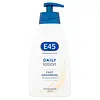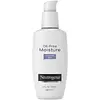What's inside
What's inside
 Benefits
Benefits

 Concerns
Concerns

 Ingredients Side-by-side
Ingredients Side-by-side

Water
Skin ConditioningGlycerin
HumectantEthylhexyl Palmitate
EmollientDimethicone
EmollientPetrolatum
EmollientCyclomethicone
EmollientGlycine Soja Sterols
EmollientIsopropyl Isostearate
EmollientCetyl Alcohol
EmollientPEG-10 Soy Sterol
EmulsifyingGlyceryl Stearate
EmollientPEG-100 Stearate
C12-15 Alkyl Benzoate
AntimicrobialCarbomer
Emulsion StabilisingTetrasodium EDTA
Sodium Hydroxide
BufferingDiazolidinyl Urea
PreservativeEthylparaben
PreservativeMethylparaben
PreservativePropylparaben
PreservativeWater, Glycerin, Ethylhexyl Palmitate, Dimethicone, Petrolatum, Cyclomethicone, Glycine Soja Sterols, Isopropyl Isostearate, Cetyl Alcohol, PEG-10 Soy Sterol, Glyceryl Stearate, PEG-100 Stearate, C12-15 Alkyl Benzoate, Carbomer, Tetrasodium EDTA, Sodium Hydroxide, Diazolidinyl Urea, Ethylparaben, Methylparaben, Propylparaben
 Reviews
Reviews

Ingredients Explained
These ingredients are found in both products.
Ingredients higher up in an ingredient list are typically present in a larger amount.
Carbomer is a polymer of acrylic acid. Its main role is to create a gel consistency.
A high amount of carbomer can cause pilling or balling up of products. Don't worry, most products contain 1% or less of carbomer.
Glycerin is already naturally found in your skin. It helps moisturize and protect your skin.
A study from 2016 found glycerin to be more effective as a humectant than AHAs and hyaluronic acid.
As a humectant, it helps the skin stay hydrated by pulling moisture to your skin. The low molecular weight of glycerin allows it to pull moisture into the deeper layers of your skin.
Hydrated skin improves your skin barrier; Your skin barrier helps protect against irritants and bacteria.
Glycerin has also been found to have antimicrobial and antiviral properties. Due to these properties, glycerin is often used in wound and burn treatments.
In cosmetics, glycerin is usually derived from plants such as soybean or palm. However, it can also be sourced from animals, such as tallow or animal fat.
This ingredient is organic, colorless, odorless, and non-toxic.
Glycerin is the name for this ingredient in American English. British English uses Glycerol/Glycerine.
Learn more about GlycerinGlyceryl Stearate is a mix of glycerin and stearic acid.
It is used to stabilize the mixing of water and oil ingredients. By preventing these ingredients from separating, it can help elongate shelf life. It can also help thicken the product's texture.
As an emollient, it helps soften skin and supports barrier-replenishing ingredients.
In cosmetics, Glyceryl Stearate is often made from vegetable oils or synthetically produced.
This ingredient may not be fungal-acne safe
Fun fact: The human body also creates Glyceryl Stearate naturally.
Learn more about Glyceryl StearateMethylparaben is a preservative and is a paraben. It is used to prevent the growth of fungus, mold, and other harmful bacteria. Parabens are chemicals used as preservatives in both cosmetics and food.
Methylparaben can be synthetically created. It can also be found naturally in some fruits, such as blueberries.
Oftentimes, Methylparaben is combined with other parabens to help increase the shelf life.
The safety of Methylparaben is currently being studied. While ongoing studies are looking into the safety of parabens, the results have been very mixed. Some studies have not found Methylparaben to be harmful.
Learn more about MethylparabenPropylparaben is a preservative and is a paraben with antifungal and antimicrobial properties.
This ingredient can be naturally found in plants and insects, but most of it is synthetically manufactured for human use. In cosmetics, it is usually created by reacting para-aminobenzoic acid and propanol (an alcohol).
You can usually find this ingredient in water-based products.
Parabens have come under controversy due to the claim they are hormone disruptors. Studies show conflicting results. We recommend speaking with a professional if you have any concerns.
Propylparaben is commonly found in food, medicine, and cosmetics.
Learn more about PropylparabenSodium Hydroxide is also known as lye or caustic soda. It is used to adjust the pH of products; many ingredients require a specific pH to be effective.
In small amounts, sodium hydroxide is considered safe to use. However, large amounts may cause chemical burns due to its high alkaline.
Your skin has a natural pH and acid mantle. This acid mantle helps prevent harmful bacteria from breaking through. The acid mantle also helps keep your skin hydrated.
"Alkaline" refers to a high pH level. A low pH level would be considered acidic.
Learn more about Sodium HydroxideWater. It's the most common cosmetic ingredient of all. You'll usually see it at the top of ingredient lists, meaning that it makes up the largest part of the product.
So why is it so popular? Water most often acts as a solvent - this means that it helps dissolve other ingredients into the formulation.
You'll also recognize water as that liquid we all need to stay alive. If you see this, drink a glass of water. Stay hydrated!
Learn more about Water